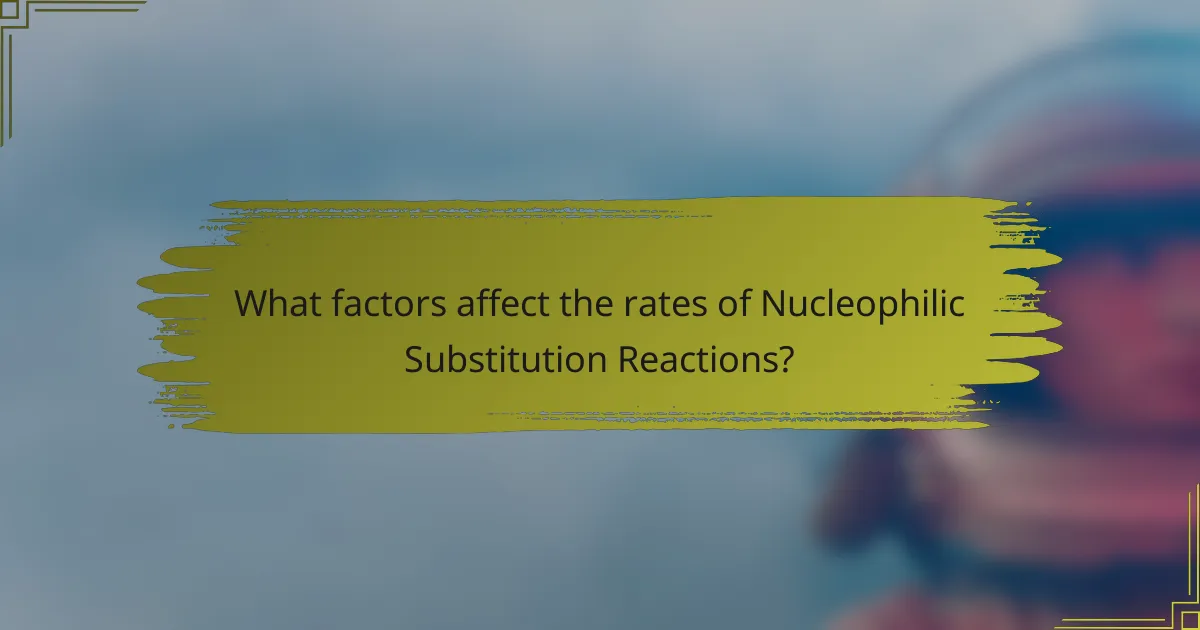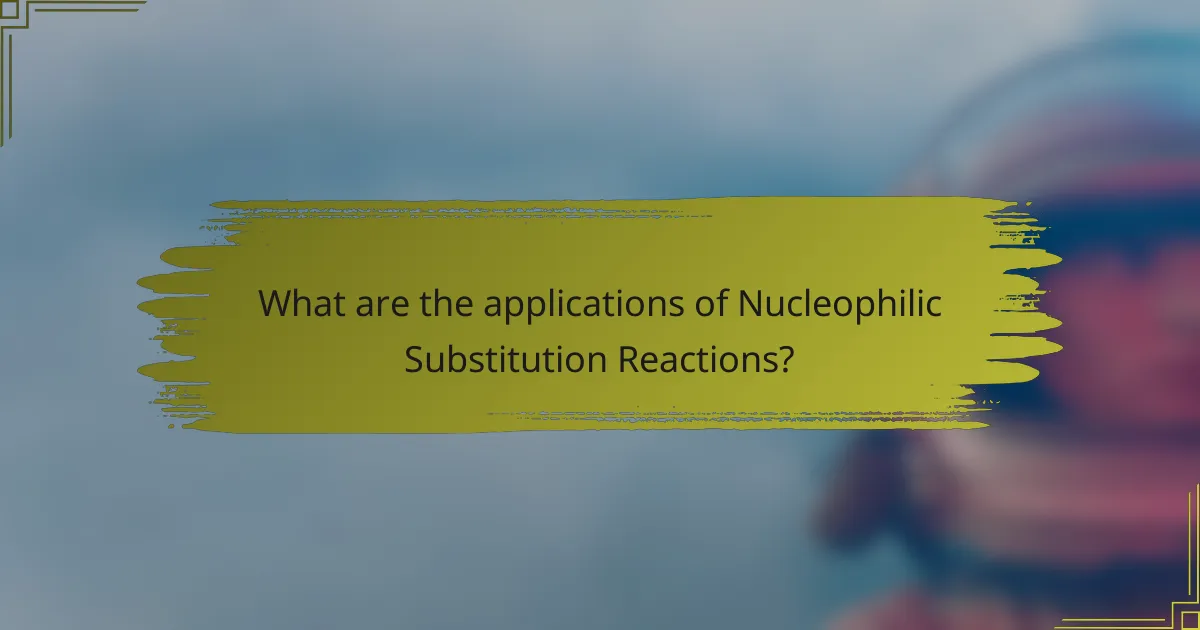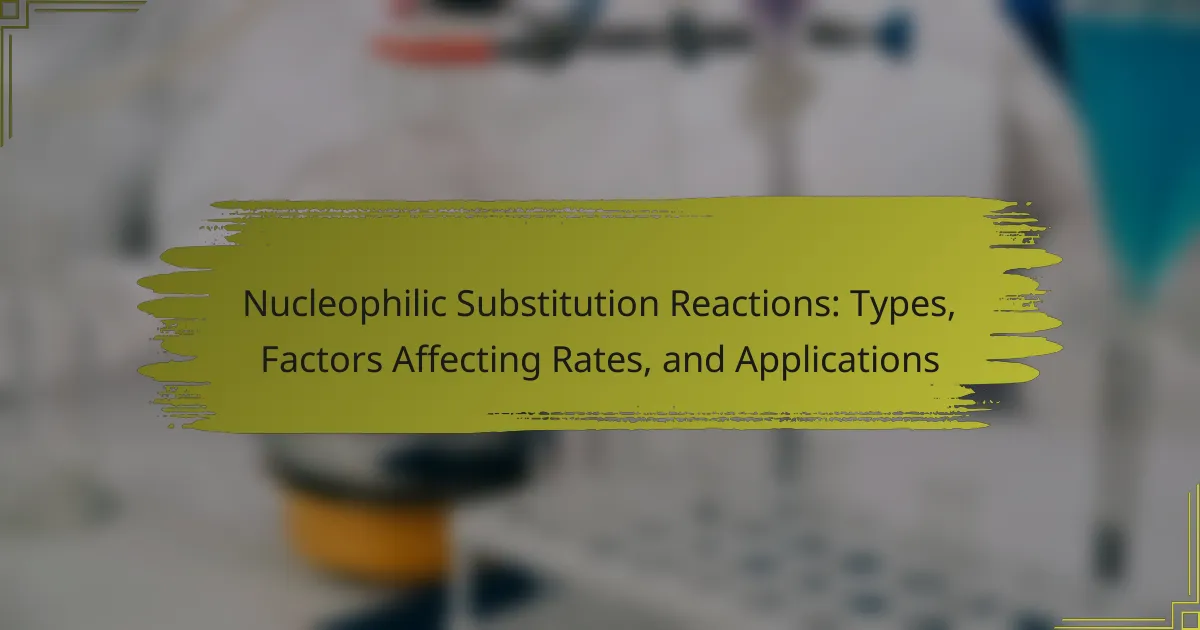
What are Nucleophilic Substitution Reactions?
Nucleophilic substitution reactions are chemical reactions where a nucleophile replaces a leaving group in a molecule. This process typically occurs in organic chemistry. The nucleophile donates an electron pair to form a new bond with the substrate. Meanwhile, the leaving group departs with a pair of electrons.
There are two primary mechanisms for these reactions: SN1 and SN2. In SN1 reactions, the leaving group first departs, forming a carbocation intermediate. Then, the nucleophile attacks the carbocation. In contrast, SN2 reactions involve a single concerted step where the nucleophile attacks the substrate as the leaving group departs.
Factors that influence the rate of nucleophilic substitution include the strength of the nucleophile, the nature of the leaving group, and the solvent used. Stronger nucleophiles generally lead to faster reactions. Good leaving groups facilitate the process, while polar protic solvents can stabilize the transition state.
Nucleophilic substitution reactions are widely used in synthetic organic chemistry. They are essential for constructing complex molecules and are foundational in drug development and chemical manufacturing.
How do Nucleophilic Substitution Reactions occur?
Nucleophilic substitution reactions occur when a nucleophile replaces a leaving group in a molecule. The nucleophile donates an electron pair to form a new bond with the carbon atom. This process typically involves two main mechanisms: SN1 and SN2. In SN1, the reaction proceeds through a two-step process. First, the leaving group departs, forming a carbocation intermediate. Then, the nucleophile attacks the carbocation. In contrast, SN2 reactions occur in a single step. The nucleophile attacks the substrate simultaneously as the leaving group departs. Factors affecting the reaction rate include the strength of the nucleophile, the stability of the leaving group, and the solvent used. Stronger nucleophiles and better leaving groups generally increase the reaction rate.
What are the key components involved in Nucleophilic Substitution Reactions?
The key components involved in nucleophilic substitution reactions are the nucleophile, the substrate, and the leaving group. The nucleophile is a species that donates an electron pair to form a new bond. Common nucleophiles include hydroxide ions and alkoxides. The substrate is the molecule undergoing substitution, typically containing a carbon atom bonded to a leaving group. The leaving group is the atom or group that departs with an electron pair. Good leaving groups stabilize the negative charge after departure. The reaction proceeds through either an SN1 or SN2 mechanism, depending on the substrate structure and reaction conditions. In SN1 reactions, the substrate first forms a carbocation intermediate. In contrast, SN2 reactions involve a concerted mechanism where the nucleophile attacks the substrate simultaneously as the leaving group departs.
What mechanisms are involved in Nucleophilic Substitution Reactions?
Nucleophilic substitution reactions primarily involve two mechanisms: SN1 and SN2. The SN1 mechanism is a two-step process. It begins with the formation of a carbocation intermediate after the leaving group departs. This is followed by the nucleophile attacking the carbocation. The rate of the SN1 reaction depends solely on the concentration of the substrate.
In contrast, the SN2 mechanism is a one-step process. It involves a simultaneous attack by the nucleophile while the leaving group departs. This results in a transition state where both the nucleophile and the substrate are partially bonded. The rate of the SN2 reaction depends on both the substrate and nucleophile concentrations.
Both mechanisms are influenced by factors such as sterics and solvent effects. SN1 reactions favor more stable carbocations, while SN2 reactions are favored by less steric hindrance.
What types of Nucleophilic Substitution Reactions exist?
There are two main types of nucleophilic substitution reactions: SN1 and SN2. SN1 reactions involve a two-step mechanism. The first step is the formation of a carbocation intermediate. The second step involves the nucleophile attacking the carbocation. SN2 reactions occur in a single concerted step. In this mechanism, the nucleophile attacks the substrate simultaneously as the leaving group departs. SN1 reactions are favored by tertiary substrates due to carbocation stability. SN2 reactions are favored by primary substrates because they have less steric hindrance.
What is the difference between SN1 and SN2 reactions?
SN1 and SN2 reactions are two types of nucleophilic substitution reactions. The key difference lies in their mechanisms. SN1 reactions proceed via a two-step mechanism involving the formation of a carbocation intermediate. This occurs when the leaving group departs first, followed by nucleophilic attack. In contrast, SN2 reactions occur in a single concerted step where the nucleophile attacks the substrate simultaneously as the leaving group departs.
SN1 reactions are favored in polar protic solvents, which stabilize the carbocation. They typically occur with tertiary substrates due to carbocation stability. SN2 reactions, however, are favored in polar aprotic solvents and generally occur with primary or secondary substrates, as steric hindrance affects the reaction rate.
The rate of SN1 reactions depends only on the concentration of the substrate, making it unimolecular. In contrast, the rate of SN2 reactions depends on both the substrate and nucleophile concentrations, making it bimolecular. Thus, SN1 and SN2 reactions differ in their mechanisms, substrate preferences, and rate dependencies.
What are the characteristics of each type of Nucleophilic Substitution Reaction?
Nucleophilic substitution reactions are classified into two main types: SN1 and SN2.
SN1 reactions are unimolecular and involve two steps. The first step is the formation of a carbocation intermediate. This occurs when the leaving group departs, resulting in a positively charged species. The second step involves the nucleophile attacking the carbocation to form the final product. SN1 reactions typically occur in polar protic solvents. They favor tertiary substrates due to carbocation stability.
SN2 reactions are bimolecular and occur in a single concerted step. The nucleophile attacks the substrate simultaneously as the leaving group departs. This results in the formation of a transition state. SN2 reactions generally take place in polar aprotic solvents. They favor primary substrates due to steric hindrance.
Each reaction type has distinct kinetics. SN1 reactions have first-order kinetics, while SN2 reactions exhibit second-order kinetics. The characteristics of these reactions influence their rates and mechanisms in organic chemistry.

What factors affect the rates of Nucleophilic Substitution Reactions?
The rates of nucleophilic substitution reactions are affected by several factors. These include the nature of the nucleophile, the leaving group, the solvent, and the substrate structure. A stronger nucleophile typically increases the reaction rate. The leaving group’s ability to depart also influences the rate; better leaving groups result in faster reactions. The solvent can stabilize charged intermediates or transition states, affecting the rate. Polar protic solvents may slow down reactions with strong nucleophiles, while polar aprotic solvents generally enhance nucleophilicity. Additionally, primary substrates react faster than secondary or tertiary due to steric hindrance.
How does the structure of the substrate influence the reaction rate?
The structure of the substrate significantly influences the reaction rate in nucleophilic substitution reactions. Substrates with more steric hindrance tend to react more slowly. For instance, tertiary substrates are usually less reactive than primary substrates due to steric crowding.
Additionally, the presence of electron-withdrawing or electron-donating groups can affect the reactivity. Electron-withdrawing groups stabilize the transition state, increasing the reaction rate. Conversely, electron-donating groups can decrease the reaction rate by destabilizing the transition state.
The hybridization of the carbon atom also plays a role. sp3 hybridized carbons are more reactive in nucleophilic substitutions compared to sp2 or sp hybridized carbons. This is due to the greater availability of the carbon’s electrons for attack by the nucleophile.
In summary, substrate structure, including sterics, electronic effects, and hybridization, directly impacts the rate of nucleophilic substitution reactions.
What role do steric effects play in Nucleophilic Substitution Reactions?
Steric effects significantly influence nucleophilic substitution reactions by affecting the accessibility of the electrophile to the nucleophile. In these reactions, steric hindrance can slow down or prevent the reaction from occurring. Bulky substituents near the electrophilic center create a barrier that the nucleophile must overcome. This hindrance is particularly pronounced in bimolecular nucleophilic substitution (SN2) reactions. In SN2 reactions, the nucleophile approaches the electrophile from the backside, and steric effects can impede this approach. Conversely, in unimolecular nucleophilic substitution (SN1) reactions, steric effects can stabilize the carbocation intermediate but may also influence the rate of the reaction. Empirical studies show that increased steric bulk around the electrophile leads to slower reaction rates in SN2 mechanisms. This relationship emphasizes the crucial role steric effects play in determining the pathway and rate of nucleophilic substitution reactions.
How does the leaving group affect the rate of reaction?
The leaving group significantly affects the rate of nucleophilic substitution reactions. A better leaving group increases the reaction rate. Good leaving groups are typically weak bases. Examples include halides like iodide and bromide. These groups can stabilize negative charges effectively. Conversely, poor leaving groups slow down reactions. Strong bases like hydroxide are poor leaving groups. Their instability leads to slower substitution rates. The bond strength between the leaving group and the substrate also plays a role. Weaker bonds facilitate faster departures of leaving groups. Thus, the nature of the leaving group is crucial in determining reaction kinetics.
What is the impact of the nucleophile on the reaction?
The nucleophile significantly impacts the reaction rate and mechanism in nucleophilic substitution reactions. A stronger nucleophile increases the reaction rate by more effectively attacking the electrophile. The nucleophile’s charge also plays a critical role; negatively charged nucleophiles are generally more reactive than neutral ones. Additionally, the nucleophile’s size and steric hindrance influence the reaction pathway. Bulky nucleophiles may favor elimination reactions over substitution. Solvent effects can further modulate nucleophilicity, with polar protic solvents stabilizing nucleophiles and potentially slowing reactions. In summary, the nature, charge, size, and solvent environment of the nucleophile are key factors that determine the outcome of nucleophilic substitution reactions.
What characteristics make a nucleophile strong or weak?
A strong nucleophile has high electron density and a negative charge. This allows it to readily donate electrons to electrophiles. Factors affecting nucleophilicity include charge, electronegativity, and solvent effects. Strong nucleophiles often possess a negative charge, such as hydroxide (OH-) or alkoxide ions (RO-). Weak nucleophiles typically have a neutral charge and higher electronegativity, like water (H2O) or alcohols (ROH). Steric hindrance also impacts nucleophilicity; bulky nucleophiles are often weaker. In polar protic solvents, nucleophilicity decreases for larger ions due to solvation effects. Conversely, in polar aprotic solvents, nucleophilicity increases as solvation is reduced.
How does the solvent choice influence the reaction rate?
The choice of solvent significantly influences the reaction rate in nucleophilic substitution reactions. Solvents can stabilize reactants, transition states, or products, affecting the overall energy barrier. Polar protic solvents can stabilize ions through hydrogen bonding, thereby increasing the reaction rate. Conversely, polar aprotic solvents can enhance nucleophilicity by not solvating anions as effectively. The dielectric constant of the solvent also plays a crucial role; higher dielectric constants generally lead to increased reaction rates. Empirical studies, such as those by S. A. Kauffman et al., demonstrate that solvent polarity directly correlates with the rates of nucleophilic substitution.

What are the applications of Nucleophilic Substitution Reactions?
Nucleophilic substitution reactions have several important applications in organic chemistry. They are used in the synthesis of pharmaceuticals and agrochemicals. These reactions facilitate the formation of new carbon-nitrogen, carbon-oxygen, and carbon-sulfur bonds. They are essential for creating complex molecules with specific functional groups. Additionally, nucleophilic substitution reactions are employed in the preparation of polymers and materials. Their ability to replace leaving groups makes them valuable in chemical transformations. This versatility supports a wide range of industrial processes. Overall, these reactions are crucial for advancing chemical synthesis and manufacturing.
In which industries are Nucleophilic Substitution Reactions commonly used?
Nucleophilic substitution reactions are commonly used in the pharmaceutical, agrochemical, and chemical manufacturing industries. In pharmaceuticals, these reactions enable the synthesis of various drugs by modifying molecular structures. Agrochemical applications include the development of pesticides and herbicides through targeted chemical transformations. The chemical manufacturing industry utilizes nucleophilic substitutions for producing intermediates and fine chemicals. These reactions are essential for creating compounds with specific functional groups, enhancing product efficacy.
How do these reactions contribute to pharmaceutical synthesis?
Nucleophilic substitution reactions are vital in pharmaceutical synthesis. They allow for the introduction of functional groups into organic molecules. This process is crucial for modifying the chemical structure of drug candidates. By altering these structures, chemists can enhance the therapeutic effectiveness of the compounds. Additionally, these reactions can improve the pharmacokinetic properties of drugs. For instance, they can increase solubility or bioavailability. Studies show that many blockbuster drugs incorporate nucleophilic substitution in their synthesis. This demonstrates the importance of these reactions in developing effective medications.
What role do Nucleophilic Substitution Reactions play in organic chemistry?
Nucleophilic substitution reactions are fundamental processes in organic chemistry. They involve the replacement of a leaving group by a nucleophile. This reaction type is crucial for synthesizing various organic compounds. It allows for the formation of new chemical bonds, which is essential in creating complex molecules.
Nucleophilic substitution reactions can occur via two primary mechanisms: SN1 and SN2. The SN1 mechanism involves a two-step process, leading to racemization in chiral centers. The SN2 mechanism occurs in a single concerted step, resulting in inversion of configuration.
These reactions are influenced by factors such as the strength of the nucleophile, the nature of the leaving group, and solvent effects. For instance, strong nucleophiles increase reaction rates, while polar protic solvents stabilize intermediates in SN1 reactions.
Overall, nucleophilic substitution reactions are pivotal in organic synthesis, pharmaceuticals, and materials science. They provide pathways to construct diverse chemical structures efficiently.
What are some practical tips for conducting Nucleophilic Substitution Reactions?
Use a strong nucleophile to enhance reaction rates. Common choices include hydroxide or alkoxide ions. Ensure the solvent is appropriate; polar protic solvents favor SN1 while polar aprotic solvents favor SN2. Maintain optimal temperature; higher temperatures can increase reaction rates but may lead to side reactions. Control steric hindrance; primary substrates react faster than secondary or tertiary ones. Monitor reaction time closely to avoid over-reaction. Utilize proper safety measures, as some reagents can be hazardous. Lastly, analyze the product using techniques like NMR or GC to confirm successful substitution.
What common mistakes should be avoided in Nucleophilic Substitution Reactions?
Common mistakes to avoid in nucleophilic substitution reactions include using the wrong nucleophile. A strong nucleophile is essential for effective substitution. Failing to consider steric hindrance can also hinder reactions. Sterically hindered substrates may not react efficiently. Not accounting for the solvent effects is another mistake. The solvent can significantly influence the reaction rate. Additionally, neglecting to check the leaving group ability can lead to poor outcomes. A weak leaving group can impede the reaction. Lastly, overlooking the reaction mechanism can result in incorrect predictions of products. Understanding whether the reaction follows an SN1 or SN2 pathway is crucial for success.
How can one optimize conditions for successful Nucleophilic Substitution Reactions?
To optimize conditions for successful nucleophilic substitution reactions, one should consider several factors. First, use a strong nucleophile to increase reaction rate. Strong nucleophiles enhance the likelihood of bond formation. Second, choose an appropriate solvent. Polar aprotic solvents often facilitate nucleophilic activity. Third, control the temperature. Higher temperatures can improve reaction kinetics. Fourth, ensure the substrate is suitable. Primary substrates favor SN2 mechanisms, while tertiary substrates favor SN1. Additionally, reduce steric hindrance around the electrophile. Less steric hindrance allows nucleophiles to attack more easily. Lastly, monitor the leaving group’s ability. Better leaving groups enhance reaction efficiency. These strategies collectively improve the likelihood of successful nucleophilic substitution reactions.
Nucleophilic substitution reactions are fundamental chemical processes in organic chemistry where a nucleophile replaces a leaving group in a molecule. This article covers the two main mechanisms of these reactions, SN1 and SN2, detailing their characteristics, factors affecting reaction rates such as nucleophile strength, leaving group ability, and solvent choice. Additionally, it explores the applications of nucleophilic substitution in various industries, including pharmaceuticals and agrochemicals, while providing practical tips for conducting these reactions effectively. Understanding these concepts is essential for advancing chemical synthesis and applications in organic chemistry.
